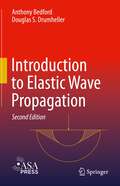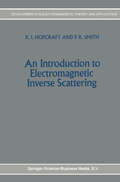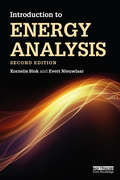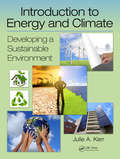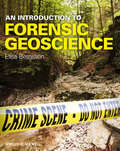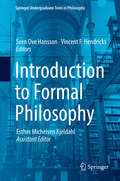- Table View
- List View
Introduction to Einstein’s Theory of Relativity: From Newton’s Attractive Gravity to the Repulsive Gravity of Vacuum Energy (Undergraduate Texts in Physics)
by Øyvind GrønThe revised and updated 2nd edition of this established textbook provides a self-contained introduction to the general theory of relativity, describing not only the physical principles and applications of the theory, but also the mathematics needed, in particular the calculus of differential forms.Updated throughout, the book contains more detailed explanations and extended discussions of several conceptual points, and strengthened mathematical deductions where required. It includes examples of work conducted in the ten years since the first edition of the book was published, for example the pedagogically helpful concept of a "river of space" and a more detailed discussion of how far the principle of relativity is contained in the general theory of relativity. Also presented is a discussion of the concept of the 'gravitational field' in Einstein's theory, and some new material concerning the 'twin paradox' in the theory of relativity. Finally, the book contains a new section about gravitational waves, exploring the dramatic progress in this field following the LIGO observations. Based on a long-established masters course, the book serves advanced undergraduate and graduate level students, and also provides a useful reference for researchers.
Introduction to Elastic Wave Propagation
by Anthony Bedford Douglas S. DrumhellerThis revised and updated edition expands on its explanations of methods used to analyze waves in solid materials, such as the waves created by earthquakes and the ultrasonic waves used to detect flaws in materials and for medical diagnoses. In addition to the traditional methods used to analyze steady-state and transient waves in elastic materials, the book contains introductions to advanced areas that no other single text covers. These topics include the use of finite elements to solve wave problems, the Cagniard-de Hoop method, the four-pole technique for analyzing waves in layered media, and the growth and decay of shock and acceleration waves. The authors explain the theory of linear elasticity through the displacement equations of motion, methods used to analyze steady-state and transient waves in layered media, and include an appendix on functions of a complex variable. Originally developed for a graduate course for which no suitable text existed, the new edition retains its classroom-tested treatment of the theories of linear elasticity and complex variables for students needing background in those subjects.
An Introduction to Electromagnetic Inverse Scattering (Developments in Electromagnetic Theory and Applications #7)
by K.I. Hopcraft P.R. SmithIntroduction to Emergency Management
by Jane Bullock George HaddowIntroduction to Emergency Management, Second Edition is a practical reference for students and professionals covering disaster response planning and mitigation. The book details the Federal Emergency Management Agency (FEMA) (U.S), the Federal Response Plan (FRP), and the roles, responsibilities, and interrelationship between FEMA and state and local emergency management systems. It also covers the changes in emergency management since the events of September 11, 2001, the latest information on the Office of Homeland Security, and includes several detailed appendices. This Second Edition is completely updated and continues this title’s success as a practical reference for students and professionals covering disaster response planning and mitigation.Includes continual connection of theory to real-world examples of disasters including the Tsunami disaster and instances of terrorismContains dozens of diagrams and statistics illustrating disaster management history and factsProvides links to Emergency Management Web sites and information sources, including homeland security sources
Introduction to Emergency Management
by Jane Bullock George Haddow Damon P. CoppolaIntroduction to Emergency Management, Third Edition provides a comprehensive update of this foundational text on the background components and systems involved in the management of disasters and other emergencies. The book details current practices, strategies, and the key players involved in emergency management, especially in the U.S. but also around the world. Expanded coverage of local and state issues, particularly as they need to interact and work with FEMA and other federal agencies, adds value to public administrators locally tasked with protecting their community. The Third Edition is fully updated to cover FEMA's continually changing role within the Department of Homeland Security and the impact and aftermath of Hurricane Katrina. Lessons including proper planning, mitigation, in-crisis decisions, evacuation, and recovery shed light on how managers can avoid devastating breakdowns in communication and leadership during an event. Not only terrorist events but many such natural disasters require similar preparedness planning. Emergency planning is vital to the security of entire communities and thus an essential focus for research, planning and training. This new edition continues in its tradition of serving as an essential resource for students and young professionals in the discipline of Emergency Management.Case examples provide current specific examples of disasters and how they were managedFull-color hurricane Katrina section with event timelineWritten by 2 former FEMA senior officials who draw on firsthand experience in day-to-day emergency management operations
Introduction to Emergency Management
by Damon P. Coppola Jane A. Bullock George D. HaddowIntroduction to Emergency Management, Seventh Edition, sets the standard for excellence in the field and has educated a generation of emergency managers. This long-trusted resource provides a broad overview of the key aspects of the emergency management profession. Readers will gain an understanding of why the emergency management profession exists, what actions its professionals and practitioners are tasked with performing, and what achievements are sought through the conduct of these various efforts. Students and new professionals alike will further gain an enhanced understanding of key terminology and concepts that enable them to work with emergency management specialists.Emphasizes climate change as a key hazard faced by disaster managersIncludes coverage of social media as a critical tool in emergency managementContains updated ancillaries, new examples, and case studies throughout
Introduction to Emergency Management
by Damon P. Coppola Jane A. Bullock George D. HaddowIntroduction to Emergency Management sets the standard for excellence in the field and has educated a generation of emergency managers. Haddow, Bullock, and Coppola return for the sixth edition with an emphasis on climate change as a major hazard. Fully updated throughout for new regulations and workflows, with new case studies covering the latest in best practices, this classic textbook prepares students for the challenges of a career in emergency management.Expanded information on disaster recovery coordination structuresEmphasis on climate change as a key hazard faced by disaster managersCoverage of social media as critical tool in emergency managementFully updated throughout for the latest regulations and workflowsNew examples and case studies throughoutUpdated ancillaries to keep course instruction fresh
Introduction to Emergency Management
by Damon P. Coppola George Haddow Jane BullockIntroduction to Emergency Management, Fifth Edition, offers a fully up-to-date analysis of US emergency management principles. In addition to expanding coverage of risk management in a time of climate change and terrorism, Haddow, Bullock, and Coppola discuss the impact of new emergency management technologies, social media, and an increasing focus on recovery. They examine the effects of the 2012 election results and discuss FEMA’s controversial National Flood Insurance Program (NFIP). Introduction to Emergency Management, Fifth Edition, gives instructors and students the best textbook content, instructor-support materials, and online resources to prepare future EM professionals for this demanding career.Introduction to FEMA's Whole Community disaster preparedness initiativeMaterial on recent disaster events, including the Boston Marathon Bombing (2013), Hurricane Sandy (2012), the Joplin Tornado (2011), the Haiti Earthquake (2011), and the Great East Japan Earthquake (2010)New and updated material on the Department of Homeland Security and the ongoing efforts of the emergency management community to manage terrorism hazardsTop-of-the-line ancillaries that can be uploaded to Blackboard and other course management systems.
Introduction to Energy Analysis
by Kornelis Blok Evert NieuwlaarThe energy supply and demand system is of great importance for society, from economic, social, and ecological viewpoints. The last decade in particular has seen rapid changes in the world of energy systems, and it is therefore now an important area for study, academic research, and professional work. This textbook provides an introduction to energy analysis for those students who want to specialise in this challenging field. In comparison to other textbooks, this book provides a balanced treatment of complete energy systems, covering the demand side, the supply side, and the energy markets that connect these. The emphasis is very much on presenting a range of tools and methodologies that will help students find their way in analysing real world problems in energy systems. Featuring learning objectives, further readings and practical exercises in each chapter, An Introduction to Energy Analysis will be essential reading for upper-level undergraduate and postgraduate students with a background in the natural sciences and egineering. This book may also be useful for professionals dealing with energy issues, as a first introduction into the field.
Introduction to Energy Analysis
by Kornelis Blok Evert NieuwlaarThe energy supply and demand system is of great importance for society, from economic, social, and ecological viewpoints. The last decade in particular has seen rapid changes in the world of energy systems, and it is therefore now an important area for study, academic research, and professional work. This textbook provides an introduction to energy analysis for those students who want to specialise in this challenging field. In comparison to other textbooks, this book provides a balanced treatment of complete energy systems, covering the demand side, the supply side, and the energy markets that connect these. The emphasis is very much on presenting a range of tools and methodologies that will help students find their way in analysing real world problems in energy systems. Featuring learning objectives, further readings and practical exercises in each chapter, An Introduction to Energy Analysis will be essential reading for upper-level undergraduate and postgraduate students with a background in the natural sciences and egineering. This book may also be useful for professionals dealing with energy issues, as a first introduction into the field.
Introduction to Energy and Climate: Developing a Sustainable Environment
by Julie KerrThe purpose of this textbook is to provide a well-rounded working knowledge of both climate change and environmental sustainability for a wide range of students. Students will learn core concepts and methods to analyze energy and environmental impacts; will understand what is changing the earth’s climate, and what that means for life on earth now and in the future. They will also have a firm understanding of what energy is and how it can be used. This text intends to develop working knowledge of these topics, with both technical and social implications. Students will find in one volume the integration and careful treatment of climate, energy, and sustainability.
Introduction to Energy and Climate: Developing a Sustainable Environment
by Julie KerrThe purpose of this textbook is to provide a well-rounded working knowledge of both climate change and environmental sustainability for a wide range of students. Students will learn core concepts and methods to analyze energy and environmental impacts; will understand what is changing the earth’s climate, and what that means for life on earth now and in the future. They will also have a firm understanding of what energy is and how it can be used. This text intends to develop working knowledge of these topics, with both technical and social implications. Students will find in one volume the integration and careful treatment of climate, energy, and sustainability.
Introduction to Environment, Biodiversity and Climate Change
by Navale PandharinathEnvironment includes air, water, land and the inter relationship between air water, land and human beings and other living creatures, plants micro-organisms and property. Environment effects the wellbeing of man, animal and plants world over. Man is more advanced in intellect and hence it is the duty of man to protect the environment from undesired pollutions. The book discusses various aspects of Global warming, climate change, health hazards, dwindling of forest, water resources and natural resources and stress on biological diversity.Note: T&F does not sell or distribute the Hardback in India, Pakistan, Nepal, Bhutan, Bangladesh and Sri Lanka.
Introduction to Environment, Biodiversity and Climate Change
by Navale PandharinathEnvironment includes air, water, land and the inter relationship between air water, land and human beings and other living creatures, plants micro-organisms and property. Environment effects the wellbeing of man, animal and plants world over. Man is more advanced in intellect and hence it is the duty of man to protect the environment from undesired pollutions. The book discusses various aspects of Global warming, climate change, health hazards, dwindling of forest, water resources and natural resources and stress on biological diversity.Note: T&F does not sell or distribute the Hardback in India, Pakistan, Nepal, Bhutan, Bangladesh and Sri Lanka.
An Introduction to Environmental Biophysics
by Gaylon S. Campbell John NormanFrom reviews of the first edition:"well organized . . . Recommended as an introductory text for undergraduates" -- AAAS Science Books and Films "well written and illustrated" -- Bulletin of the American Meteorological Society
An Introduction to Environmental Biotechnology
by Milton WainwrightAn Introduction to Environmental Biotechnology provides an introduction to the subject of environmental biotechnology. Environmental biotechnology refers to the use of micro-organisms and other living systems to solve current environmental problems such as the detoxification of pollutants and clean-up of oil tanker spills. Additionally, it refers to the biotechnology of the agricultural environment, as well as the use of biopesticides and the application of microorganisms to the mining, metal recovery and paper industries. This is the only comprehensive introductory account of this subject matter. Beginning with an introduction to microbial growth, An Introduction to Environmental Biotechnology aims to provide the non-specialist with a complete overview of environmental biotechnology. It is presented in an easy to read style with illustrations and includes frequent references to the use of higher plants as well as micro-organisms in environmental biotechnology. An Introduction to Environmental Biotechnology is geared toward a non-specialist audience, including engineers and environmental chemists, and environmental scientists who have limited knowledge of microbiology and biotechnology.
Introduction to Environmental Economics and Policy in Japan
by Toshi H. Arimura Akira HibikiThis textbook demonstrates how economic theories can be used for environmental policy evaluations. A notable feature of this book is that, unlike most textbooks in environmental economics written in English, it draws on examples from Japan’s policy on energy, resource, pollution, and carbon emissions. Policy measures discussed in this book include controls on motor vehicle emissions, pricing of waste disposal, deposit-refund scheme for recycling, carbon taxes and emissions trading schemes. With topics involving transboundary environmental concerns such as climate change, air pollution, and waste management and recycling, the book also integrates international perspectives and provides comparisons of policies across regions and countries. A major objective of this book is to present a concise and accessible introduction to environmental economics as applied to policy evaluations in and beyond Japan. The knowledge available from this book must be very useful for students, policymakers and practitioners who seek environmental policy solutions from an economic point of view. This is an open access book.
Introduction to Environmental Geotechnology
by Hsai-Yang Fang Ronald C. ChaneyThis new edition of a bestseller presents updated technology advances that have occurred since publication of the first edition. It increases the utility and scope of the content through numerous case studies and examples and an entirely new set of problems and solutions. The book also has an accompanying instructor's guide and presents rubrics by which instructors can increase student learning and evaluate student outcomes, chapter by chapter. The book focuses on the increasing importance of water resources and energy in the broader context of environmental sustainability. It’s interdisciplinary coverage includes soil science, physical chemistry, mineralogy, geology, ground pollution, and more.
Introduction to Environmental Geotechnology
by Hsai-Yang Fang Ronald C. ChaneyThis new edition of a bestseller presents updated technology advances that have occurred since publication of the first edition. It increases the utility and scope of the content through numerous case studies and examples and an entirely new set of problems and solutions. The book also has an accompanying instructor's guide and presents rubrics by which instructors can increase student learning and evaluate student outcomes, chapter by chapter. The book focuses on the increasing importance of water resources and energy in the broader context of environmental sustainability. It’s interdisciplinary coverage includes soil science, physical chemistry, mineralogy, geology, ground pollution, and more.
An Introduction to Finite Tight Frames (Applied and Numerical Harmonic Analysis)
by Shayne F. WaldronThis textbook is an introduction to the theory and applications of finite tight frames, an area that has developed rapidly in the last decade. Stimulating much of this growth are the applications of finite frames to diverse fields such as signal processing, quantum information theory, multivariate orthogonal polynomials, and remote sensing. Featuring exercises and MATLAB examples in each chapter, the book is well suited as a textbook for a graduate course or seminar involving finite frames. The self-contained, user-friendly presentation also makes the work useful as a self-study resource or reference for graduate students, instructors, researchers, and practitioners in pure and applied mathematics, engineering, mathematical physics, and signal processing.
An Introduction to Fluid Mechanics (Springer Textbooks in Earth Sciences, Geography and Environment)
by Chung FangThis textbook provides a concise introduction to the mathematical theory of fluid motion with the underlying physics. Different branches of fluid mechanics are developed from general to specific topics. At the end of each chapter carefully designed problems are assigned as homework, for which selected fully worked-out solutions are provided. This book can be used for self-study, as well as in conjunction with a course in fluid mechanics.
An Introduction to Forensic Geoscience
by Elisa BergslienAn Introduction to Forensic Geoscience provides fundamental training in geoscience as developed through the lens of its forensic applications. It incorporates a range of topics including geophysical methods of grave detection, the mineralogy of art, identification of microfossils, and comparison of soil trace evidence samples. Each topic is introduced using core concepts that are developed with increasing complexity in order to give readers an understanding of the underlying scientific principles involved and a taste of the wide range of possible forensic uses. A variety of detailed reference tables have been compiled for the text and each chapter contains lists of references to applicable textbooks and journal articles. Examples of real criminal cases are also presented in each chapter to make the connections between theory and real world application. The goal of this book is to give readers a familiarity with the wide range of ways in which geoscience principles and geological materials can be utilized forensically. Additional resources for this book can be found at: http://www.wiley.com/go/bergslien/forensicgeoscience.
An Introduction to Forensic Geoscience
by Elisa BergslienAn Introduction to Forensic Geoscience provides fundamental training in geoscience as developed through the lens of its forensic applications. It incorporates a range of topics including geophysical methods of grave detection, the mineralogy of art, identification of microfossils, and comparison of soil trace evidence samples. Each topic is introduced using core concepts that are developed with increasing complexity in order to give readers an understanding of the underlying scientific principles involved and a taste of the wide range of possible forensic uses. A variety of detailed reference tables have been compiled for the text and each chapter contains lists of references to applicable textbooks and journal articles. Examples of real criminal cases are also presented in each chapter to make the connections between theory and real world application. The goal of this book is to give readers a familiarity with the wide range of ways in which geoscience principles and geological materials can be utilized forensically. Additional resources for this book can be found at: http://www.wiley.com/go/bergslien/forensicgeoscience.
Introduction to Formal Philosophy (Springer Undergraduate Texts In Philosophy Ser.)
by Sven Ove Hansson Vincent F. Hendricks Esther Michelsen KjeldahlThis Undergraduate Textbook introduces key methods and examines the major areas of philosophy in which formal methods play pivotal roles. Coverage begins with a thorough introduction to formalization and to the advantages and pitfalls of formal methods in philosophy. The ensuing chapters show how to use formal methods in a wide range of areas. Throughout, the contributors clarify the relationships and interdependencies between formal and informal notions and constructions. Their main focus is to show how formal treatments of philosophical problems may help us understand them better. Formal methods can be used to solve problems but also to express new philosophical problems that would never have seen the light of day without the expressive power of the formal apparatus. Formal philosophy merges work in different areas of philosophy as well as logic, mathematics, computer science, linguistics, physics, psychology, biology, economics, political theory, and sociology. This title offers an accessible introduction to this new interdisciplinary research area to a wide academic audience.

